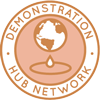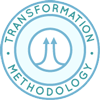
Cob Village – One Community Pod 3
The Cob Village will provide 20 resident units and eight visitor units with a social, recreational, and developmental focus on artistic and creative expression. In support of this, this village will provide a central playhouse and presentation structure and four different wings dedicated to art and creativity. Each wing will feature a different large-scale maker space and a separate large-scale social and recreation space. The village will house 50+ people and be open source shared with all the same details, and level of detail, used in the Earthbag Village and Straw Bale Villages.
This page contains the following sections related to the Cob Village:
- What is a Cob Village
- Why a Cob Village
- Ways to Contribute
- Advantages of Cob Construction
- Disadvantages/Limitation of Cob Construction
- Additional Cob Village Pictures and Details
- Maker Spaces
- Northwest-wing Living Spaces
- Northeast-wing Living Spaces
- Southwest-wing Living Spaces
- Southeast-wing Living Spaces
- Central dining hall, presentation and theater space
- Rooftop dining and recreation space
- Open source playground
- Other outdoor spaces
- Interior/Exterior design inspiration and color palette
- Resources
- Summary
- FAQ
- Consultants for this component of One Community
ALL VILLAGES (Click icons for complete pages)
Here is a book overview about the entire One Community project also:
If the above plugin doesn't allow fullscreen, try a different browser. If that or anything else still isn't working for you, you can download a copy of the above book here: Book PDF download (128 MB)
COB VILLAGE SEARCH ENGINE
WHAT IS A COB VILLAGE
![]() Cob is an ancient building material composed of dirt, straw, and water that may have been used for construction since prehistoric times. Some of the oldest man-made structures in Afghanistan are composed of rammed earth and cob and still standing! We will build the cob village to offer another open source self-sufficient and self-replicating teacher/demonstration community, village, and city option for community living, eco-tourism establishment, and global propagation and education.
Cob is an ancient building material composed of dirt, straw, and water that may have been used for construction since prehistoric times. Some of the oldest man-made structures in Afghanistan are composed of rammed earth and cob and still standing! We will build the cob village to offer another open source self-sufficient and self-replicating teacher/demonstration community, village, and city option for community living, eco-tourism establishment, and global propagation and education.
This village will also offer four maker spaces. These maker spaces will provide creative and educational design space for all residents and visitors. The central hall will provide large-scale dining and seating for 200+ people with two stages for presentations of artistic creations, dance, comedy, and theater. The maker spaces are in the north half of each living space and will include:
- A Wood Maker Space (Northwest Wing)
- A Metal and Glass Maker Space (Northeast Wing)
- A Painting, Sculpting, Masonry, Tile Work, and Pottery Maker Space (Southwest Wing)
- A Weaving and Textile Maker Space (Southeast Wing)
In addition to the maker spaces and central dining and presentation space, this village will also offer:
- Laundry for 300+
- Resident and rental living spaces
- Rooftop dining and recreation space
- Open source cob playground design
- Open source rainwater catchment and recycling
- Open source natural greywater processing and reuse
- Open source integration with One Community’s Highest Good food components
THE LAYOUTS OF THE MAKER SPACES STILL NEED TO BE DESIGNED. CONTACT US IF YOU HAVE EXPERTISE IN ONE OF THESE AREAS AND WOULD LIKE TO HELP
WHY A COB VILLAGE
![]() Cob construction has been used for thousands of years, can be formed into most shapes, and is very sustainable as a building material. As One Community continues open sourcing large-scale sustainable village models, the Cob Village will utilize the remaining straw from Pod 2 (and more as needed) to demonstrate what is possible with large-scale sustainable construction using cob and rammed earth. The maker spaces and associated living spaces will house top artists interested in sharing their gifts and creative talents with One Community, each other, the world through open source videos and classes, and visitors as part of the One Community fulfilled living model and their community contribution towards further development of the 7 sustainable villages and internships within the Highest Good education program.
Cob construction has been used for thousands of years, can be formed into most shapes, and is very sustainable as a building material. As One Community continues open sourcing large-scale sustainable village models, the Cob Village will utilize the remaining straw from Pod 2 (and more as needed) to demonstrate what is possible with large-scale sustainable construction using cob and rammed earth. The maker spaces and associated living spaces will house top artists interested in sharing their gifts and creative talents with One Community, each other, the world through open source videos and classes, and visitors as part of the One Community fulfilled living model and their community contribution towards further development of the 7 sustainable villages and internships within the Highest Good education program.

One Community Cob Village | Concept Render – Front View
WAYS TO CONTRIBUTE TO EVOLVING THIS SUSTAINABILITY COMPONENT WITH US
SUGGESTIONS | CONSULTING | MEMBERSHIP | OTHER OPTIONS
CLICK THESE ICONS TO JOIN US THROUGH SOCIAL MEDIA
ADVANTAGES OF COB CONSTRUCTION
The Advantages of cob construction are many:
- Artistic construction: Building artistically with cob is very easy because the substance is so pliable. When you build with cob, you are literally building your walls one small lump of material at a time. This makes sweeping curves, slopes, waves, and geometric designs easy to sculpt with cob
- Abundant building materials: Made with clay, sand, and straw
- Cob is energy-efficient because it has high thermal mass, meaning it can soak up unwanted heat during the daytime and release it at night when outside temperatures cool down. In addition, because cob homes are not angular and rigid, structural openings for windows can be carved in at the perfect orientation to take full advantage of indigenous sun angles (for the harvest of natural light and the sun’s passive solar heat)
- Long lasting: Cob is a very old building method. There are homes still standing today in Wales, United Kingdom, that are at least 500 years old
- Fireproof: Cob does not burn
- Termite proof: The soil, sand, clay, and straw found in cob is not consumed by termites, burrowing insects, or rodents, which makes cob immune to the attack of destructive pests
- Strong earthquake resistance: Because the straw, which is part of the cob mix, acts like a natural rebar to hold the whole structure together as one monolithic piece. This makes cob homes extremely solid and resistant
- Anyone can build with cob: It is not required to be an expert to help in the building process and even children can assist in many instances
- Supports community involvement: Building a home with cob is best performed with a group and the experience, while very hard work, has been described as “transformational” for the group involved
- Healthy: Because cob homes eschew the use of manufactured materials that flake and outgas, indoor air is kept pure, clean and free of pollutants, making these homes ideal for those who struggle with allergies. Cob is also a naturally porous material, so cob walls will “breathe” quite readily, and this helps keep indoor air circulating efficiently
- Artistic: Because of cob’s wonderful pliability, the interior of a cob house can be shaped and formed to include niches, grooves, natural shelves, and benches that emerge directly from the walls
- Quiet: Earthen walls absorb sound marvelously regardless of the source, so indoor sounds do not reverberate and outdoor noise fails to penetrate
- Biodegradable, recyclable, and the material’s color reflects the local soil to blend in aesthetically
- Cob, dug and mixed on site manually, removes the need for transportation and the resulting carbon emissions
- Low energy use during construction and no pollution produced during the building process
LIMITATIONS/DISADVANTAGES
OF COB CONSTRUCTION
Cob construction also has some limitations:
- Hard to get permitted: Cob can be very difficult to get permitted because cob is not covered by building codes, which gives county administrators great leeway when deciding whether or not to issue building permits for these sorts of structures. In urban and suburban environments, approval might be all but impossible, while in other areas you might have to involve a structural engineer and an architect in the process before a building permit can be issued
- Very labor intensive during construction: While it is theoretically possible to build a cob house of any size, because of the time and labor involved and the desire most have to keep costs down, anything larger than a moderate-sized two-bedroom home might not be practical. If the goal is to construct a full-time residence, cob is undoubtedly best suited for individuals, couples, and small families; it is always a great choice for smaller structures, however, like cabins, art studios, or tree houses
- Poor insulatory properties: Because it is porous, cob is not a very good insulating material. Of course, insulation can be added to walls, ceilings, and under floors, but even then cob houses would still be difficult to keep warm in really cold climates such as those found in the northern United States. Cob houses are excellent for those who live in desert climates, where cob’s high thermal mass properties can regulate indoor temperatures quite effectively, and they work just fine in places where it does not freeze much in the winter. But in frigid locations they would consume too much energy (for wintertime heating) to be practical
- Needs drying time: The build process is slow ” up to 15 months to allow phases to dry
- Will shrink: After completion, it can take several months for building to finish shrinking
- Larger than average space needs: Wall thickness means a new cob home requires a larger footprint than a “normal” home
- Relatively few builders are skilled in using, constructing, or repairing cob
- Construction cannot take place in wet weather and is therefore largely restricted to dry summer months
- Cob is susceptible to water damage
ADDITIONAL COB VILLAGE DETAILS
All aspects of the Cob Village will be open sourced for replication as either individual components or as part of the complete village, just as we are doing with the Duplicable City Center, Earthbag Village (Pod 1), and Straw Bale Villages. Once those three are complete, we will produce for this village the same level of detail for the materials lists, build-time and labor details, construction plans, permitting needs and strategies, and much more for all components. Here are additional images and overviews of some of the key components of this this village:
- Maker Spaces
- Northwest-wing Living Spaces
- Northeast-wing Living Spaces
- Southwest-wing Living Spaces
- Southeast-wing Living Spaces
- Central dining hall, presentation and theater space
- Rooftop dining and recreation space
- Open source playground
- Other outdoor spaces
- Interior/exterior design inspiration and color palette
MAKER SPACES
The maker spaces in the Cob Village are designed to expand the ability of One Community to create furniture, clothing, tiles, pottery, and other desired components for the villages while offering open source classes and how-to tutorials for all these areas and creations. With this in mind, each of the 4 maker-space wings will provide 10 fully stocked personal workstations, 3 general work stations, 2 measuring and assembly work stations, and at least 1 of each advanced workstation. They are large enough to meet the design and creation needs of the villages that will follow this one and capable of hosting classes of 30-50 people with minimal waiting for machinery.
To assist with the design process, the workshops within the the maker spaces were divided into three types:
- Abrasive Workshops, which create major noise and dust
- Ablative Workshops, which create or treat surfaces and require a dust free environment
- Free Workshops, which have little to no special condition or requirement
Abrasive workshops include the Wood Maker Space, Metal Maker Space, and Sculpting, Masonry, Tile Work, and Pottery Maker Space. Ablative workshops include the Glass Maker Space and Painting Maker Space. Free workshops include the Tile Work and Pottery Maker Space and Weaving and Textile Maker Space. The craftspeople that will use these spaces the most will live in the adjacent and attached housing.
NORTHWEST WING: WOOD MAKER SPACE
The Wood Maker Space will feature 10 personal workstations and all the equipment needed for large or small professional woodworking projects. This maker space will expand our upcycling and repair ability for wood items while also providing everything we need to open source designs and classes for furniture, art pieces, high-quality and sustainable custom trim, moulding, etc. The maker space will look something like this image and we’ve included our initial tool and machinery plans below.
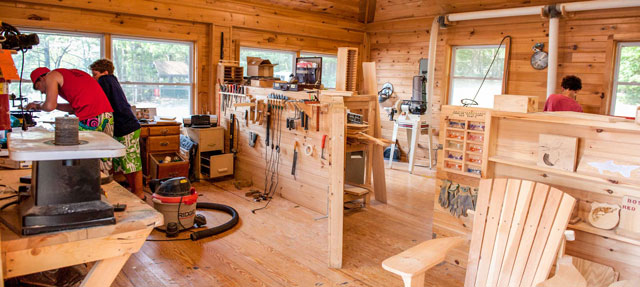
Personal Work Spaces (10)
Workbench, screw stock, measuring tools, hammers, pliers, screwdrivers, drill, screw drills, files, handsaw, rags, oil, sandpaper, spatula, wood glue, stock clamps, polishing tools, set of wooden hammers and chisels, knife, full set of battery-charged hand tools, Dremel style power tool.
20-foot Free Range General Workstations (3)
Table saw, belt sander, table buzz saw, drill stand, turn bench, manual CnC cutter, table grinder, saw horses.
Assembly and Measuring Stations (2)
Absolute-level table, levels, hair rulers, light box, assembly tools, clamps, pulleys, belt straps, scale, stock clamps, glues.
Advanced Workstation
Computer assisted CnC machine and sanding station.
Painting Sealing Station
Washable curtains, pulleys, chains, saw horses, clamps, stock clamps, goggles, gloves, apron, wood sealer, airbrush compressor, airbrush system, hooks, paints, filter masks, brushes, wood oils, stains.
General Items
Wash station, fire extinguisher, emergency off button, noise protection plugs, protection glasses, gloves, steel toed shoes, electric crane, first aid kit.
Storage and Supply Station
Industrial shelves at least 20 feet long, sorting cabinets for screws, nuts, pegs and parts, stock clamps, dollies, manual fork lift, parts register and index, lockers and strongboxes with locks for projects.
NORTHEAST WING: METAL & GLASS MAKER SPACE
The Metal and Glass Maker Space will feature 10 personal work stations and all the equipment needed for large or small professional metal and glass projects. This maker space will add to our upcycling of metal and glass and allow us to open source designs and classes for making and repairing our own machinery and equipment parts, furniture, art, dishware, and more. It will look something like this image and we’ve included our initial tool and machinery plans below.

Metal Personal Work Spaces (10)
Workbench, screw stock, measuring tools, hammers, pliers, screwdrivers, drill, tin cutter, screw drills, files, handsaw, rags, oil, sandpaper, full set of battery-charged hand tools.
Glass Personal Work Spaces (5)
Workbench, screw stock, pliers, measuring tools, drill, glass cutter, stoneware stamps, files, stoneware stencils, stoneware molds, table mounted gas torch, polishing tools, engraving tools, Dremel-style power tool, table mounted magnifying glass, water tank and leather rags, molding tools.
20-foot Metal Free Range General Workstations (3)
Metal saw, Metal folding bench, Pipe bender, belt sander, lever cutter, table buzz saw, drill stand, turn bench, manual CnC cutter
Metal Assembly and Measuring Stations (2)
Absolute Level table, levels, hair rulers, light box, assembly tools, clamps, pulleys, chains, scale.
Glass Assembly and Cutting Stations (2)
Wooden level table, suction clamps, blankets, steel ruler, utility glass cutters, removable assembly support clay or play dough, and dollies with upright bars.
Metal Advanced Workstation
Computer-assisted CnC machine, computer assisted flow jet, sanding station.
Glass Hearth Kiln
Gas hearth or Kiln, stoneware mold pliers, stoneware stencil pliers, glass blowing bowl molds, fire repelling curtains, stoneware cooling rack, glass cutter, goggles, leather gloves, leather apron, water tank and leather rags.
Welding-Forging Station
Fire-repelling curtains, pulleys, chains, welding table, clamps, magnetic clamps, electric welder, gas welder, plasma cutter, anvil, forge, pliers, hammers, cooling tank, cooling forge, goggles, leather gloves, leather aprons.
Metal General Items
Wash station, fire extinguisher, emergency off button, noise protection plugs, protection glasses, gloves, steel toed shoes, electric crane, first aid kit, cut-safe gloves.
Glass General Items
Wash station, fire extinguisher, emergency off button, noise protection plugs, protection glasses, gloves, steel toed shoes, first aid kit, fine broom, cut-safe gloves.
Metal Storage and Supply Station
Industrial shelves at least 20 feet long, sorting cabinets for screws, nuts and parts, magnetic clamps, gas bottle storage cage, dollies, manual fork lift, parts register and index, lockers and strongboxes with locks for projects
Glass Storage and Supply Station
Upright wooden storage shelves, gas bottle storage cage, lockers and strongboxes with locks for projects, suction clamps,
SOUTHWEST WING: PAINTING, MASONRY, AND POTTERY MAKER SPACE
The Painting, Sculpting, Masonry, Tile Work, and Pottery Maker Space will feature 10 personal work stations and all the equipment needed for large or small professional painting, sculpting, masonry, tile, and pottery projects. It will look something like this image and we’ve included our initial tool and machinery plans below.

Painting Personal Work Spaces (10)
Workbench, screw stock, measuring tools, pliers, screwdrivers, drill, tin cutter, files, handsaw, rags, oil, sandpaper, full set of rechargeable battery-powered tools, polishing tools, brushes, sponges, etc.
Masonry Personal Work Spaces (5)
Workbench, screw stock, measuring tools, hammers, pliers, screwdrivers, drill, files, handsaw, rags, oil, full set of rechargeable battery-powered tools, chisels.
Tile Work and Pottery Personal Work Spaces (5)
Workbench, screw stock, measuring tools, hammers, pliers, files, rags, Dremel-style power tools, pottery paints, brushes, tile cutter, turn table, cutting wire.
Painting Stations (2)
High air exchange rate low-pressure fans, dehumidifier, dust free environment, washable curtains, pulleys, chains, saw horses, clamps, stock clamps, goggles, gloves, apron, airbrush compressor, airbrush system, hooks, paints, filter masks, brushes, wood oils, stains.
20-foot Free Range Masonry General Workstations (2)
Water cooled belt saw, belt sander, water cooled table buzz saw, water cooled drill stand, water cooled turn bench, water cooled manual CnC grinder.
Welding – Forging Station
Fire repelling curtains, pulleys, chains, welding table, clamps, magnetic clamps, electric welder, gas welder, plasma cutter, anvil, forge, pliers, hammers, cooling tank, cooling forge, goggles, leather gloves, leather apron.
Ceramic and Casting Station
Ceramic and mortar mixers, pulleys, belt straps, casting molds, stencils, hammer, sledge hammer, chisels, drying racks, power tools, goggles, leather gloves, leather apron, metal trays, cutting wire, dive tank, ladles, ceramic paints.
Powder Station (Painting)
High air exchange rate low pressure fans, dehumidifier, dust free environment, washable curtains, pulleys, chains, saw horses, clamps, stock clamps, goggles, gloves, apron, airbrush compressor, airbrush system, hooks, filter masks, low current transformer, cables, cable clamps, pigment powders
Masonry Assembly and Measuring Station
Absolute Level table, levels, hair rulers, light box, assembly tools, clamps, pulleys, chains, scale, electric crane.
Masonry Advanced Workstation
Computer assisted CnC machine, computer assisted flow jet , sanding station.
Mortar and Casting Station (Masonry)
Concrete and mortar mixers, pulleys, belt straps, chains, casting molds, stencils, jackhammer, sledge hammer, chisels, drying racks, power tools, goggles, leather gloves, leather aprons.
Hearth Kiln (Tile Work and Pottery)
Gas hearth or Kiln, stoneware mold pliers, stoneware stencil pliers, fire repelling curtains, stoneware cooling racks, tile cutter, goggles, leather gloves, leather apron, water tank and leather rags. Listen to the last 20 minutes of this Paul Wheaton “Podcast 620 ” Biophilic Design and BBB session 5 ” Part 3” for a discussion on an amazing/first-ever rocket mass kiln demonstration they did. This followup “Podcast 631 ” 2022 PTJ Recap Session 3 ” Part 2” share evolutions of the design and testing process.
Painting – General Items
Wash station, fire extinguisher, emergency off button, noise protection plugs, protection glasses, gloves, steel toed shoes, electric crane, first aid kit, filter masks.
Masonry – General Items
Wash station, fire extinguisher, emergency off button, noise protection plugs, protection glasses, gloves, steel toed shoes, electric crane, first aid kit, filter masks.
Tile Work and Pottery – General Items
Wash station, fire extinguisher, emergency off button, noise protection plugs, protection glasses, gloves, steel toed shoes, electric crane, first aid kit, cut-safe gloves.
Painting Storage and Supply Station
Industrial shelves, upright shelves, sorting cabinets for parts and paints, dollies, manual fork lift, parts register and index, lockers and strongboxes with locks for projects.
Masonry Storage and Supply Station
Industrial shelves at least 20 feet long, upright shelves, sorting cabinets for screws, nuts and parts, lever clamps, dollies, manual fork lift, parts register and index, lockers and strongboxes with locks for projects.
Tile Work and Pottery Storage and Supply Station
Industrial shelves, sorting cabinets for parts, belt straps, gas bottle storage cage, dollies, manual fork lift, parts register and index, lockers and strongboxes with locks for projects.
SOUTHEAST WING: WEAVING/TEXTILE MAKER SPACE
The Weaving and Textile Maker Space will feature 10 personal work stations and all the equipment needed for large or small professional weaving and textile projects. This maker space will allow us to make our own clothing, bedding, custom drapes, etc. We will also teach and open source classes related to these areas. The maker space will look something like this image and we’ve included our initial tool and machinery plans below.

Personal Work Spaces (10)
Workbench, measuring tools, hammers, cutting tools, rags, oil, stains, stamps, stencils, weaving loom, glues, embroidering tools, marking chalks, knitting and crochet tools.
General Workstations (3)
Industrial-sized washers, industrial sized dryers, ironing stations, large wooden worktable.
Advanced Workstation
Large wooden table, powder printer, heat gun, stamps, stencils, industrial loom, industrial sowing machines, leather work tools, hammers, pliers, cobbler anvil, computer assisted embroidering machine, power cutting tools, chalks.
Dye Workstation
Dye tanks top-loaded, boiler tanks, rinse and wash tanks, drying racks, leather gloves, leather apron, googles, filter masks, acid and soap burn first aid kits, wooden paddles and ladles.
General Items
Wash station, fire extinguisher, emergency off button, noise protection plugs, protection glasses, gloves, steel toed shoes, electric crane, first aid kit, cut-safe gloves.
Storage and Supply Station
Industrial shelves and racks, sorting cabinets for parts, clamps, gas bottle storage cage, dollies, power cutter, manual fork lift, parts register and index, lockers and strongboxes with locks for projects
LIVING SPACES
The Cob Village features 4 different resident designs for each of the 4 wings of the village.
NORTHWEST WING LIVING SPACES
The northwest wing of the Cob Village will house six residences in addition to the Wood Maker Space. The living spaces in this area feature high-arched roofs that will contribute to rainwater capture, large and open floor plans, attached bathrooms, and unique window designs for each unit that will be created with 100% reclaimed windows. This wing of the building is set back sufficiently from the south wing to eliminate shading of these residences while also providing outdoor recreational spaces between the north and south wings. It is separated from the Wood Maker Space with a corridor for added safety and to eliminate noise and dust that could otherwise permeate the attached social and recreation space.

One Community Cob Village | Concept Render – Northwest Wing Looking South

One Community Cob Village | Concept Render – Northwest Wing Looking Northwest

One Community Cob Village | Concept Render – Northwest Wing Looking Down From Above

One Community Cob Village | Concept Render – Northwest Wing Bathroom
NORTHEAST WING LIVING SPACES
The northeast wing of the Cob Village will house six residences in addition to the Metal and Glass Maker Space. The living spaces in this area feature high-sloped and layered roofs that will contribute to rainwater capture, large and open floor plans, and attached bathrooms. This wing of the building is set back sufficiently from the south wing to eliminate shading of these residences while also providing outdoor recreational spaces between the north and south wings. It is separated from the Metal and Glass Maker Space with a corridor for added safety and to eliminate noise and dust that could otherwise permeate the attached social and recreation space.

One Community Cob Village | Concept Render – Northeast Living Space Looking West

One Community Cob Village | Concept Render – Northeast Living Space Looking Southwest

One Community Cob Village | Concept Render – Northeast Living Space Looking East
SOUTHWEST WING LIVING SPACES
The southwest wing of the Cob Village will house eight residences in addition to the Painting, Sculpting, Masonry, Tile Work, and Pottery Maker Space. The living spaces in this area feature dome lofts with views, smaller floor plans, and separate bathrooms.

One Community Cob Village | Concept Render – Section View of the Westside Living Spaces Looking North

One Community Cob Village | Concept Render – Southwest Living Space Looking South

One Community Cob Village | Concept Render – Southwest Living Space Looking North

One Community Cob Village | Concept Render – Westside Living Space Upstairs View
SOUTHEAST WING LIVING SPACES
The southeast wing of the Cob Village will house eight residences in addition to the Weaving and Textile Maker Space. The living spaces in this area feature high ceilings and lofts with views, smaller floor plans, and separate bathrooms.
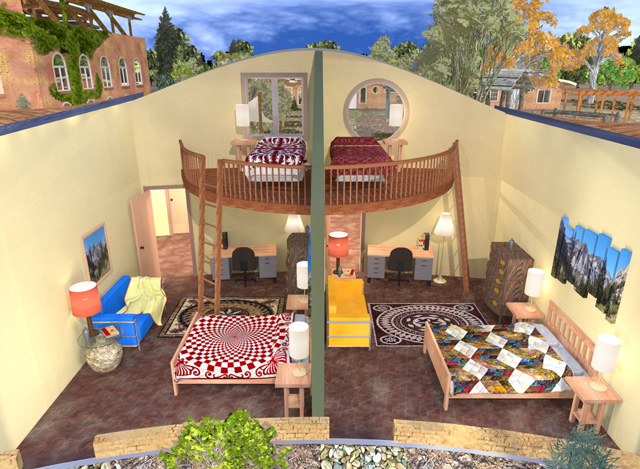
One Community Cob Village | Concept Render – Southeast Living Space Looking North Cutaway View

One Community Cob Village | Concept Render – Southeast Living Space Looking South

One Community Cob Village | Concept Render – Southeast Living Space
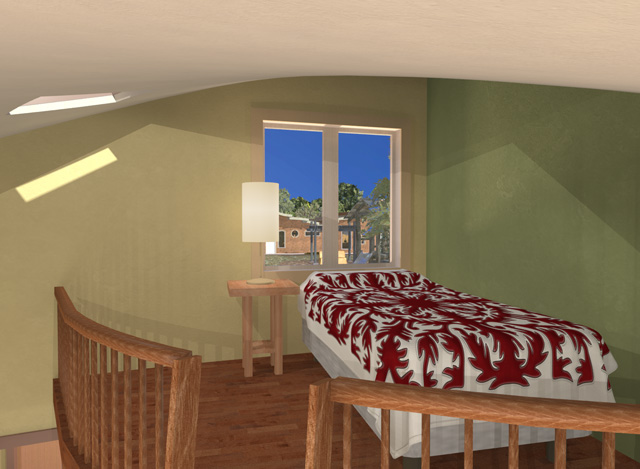
One Community Cob Village | Concept Render – Southeast Living Space Looking North Loft View
CENTRAL DINING HALL, THEATER, AND PRESENTATION SPACE
The central dining and recreation hall will provide large-scale dining and seating for 200+ people with two stages for presentations of artistic creations, dance, comedy, and theater. This dining hall features a full commercial kitchen, walk-around second floor with additional seating, elevator for wheelchair access, and enough space for conventions of 400+.
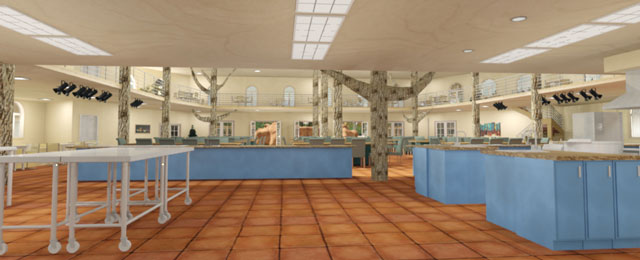
One Community Cob Village | Concept Render – Central Dining and Stage Area – View Looking North from Kitchen | Click to enlarge

One Community Cob Village | Concept Render – Central Dining and Stage Area – View from Front Doors | Click to enlarge

One Community Cob Village | Concept Render – Central Dining Area – View from 2nd Floor | Click to enlarge
More concept renders coming…
ROOFTOP DINING AND RECREATION SPACE
On top of the central dining and recreation hall is the rooftop dining and recreation space. This space will feature covered and uncovered seating for eating, recreation, and relaxation plus outdoor grills, tables, and additional seating for hosting private and group activities and festivities.

One Community Cob Village | Concept Render – Rooftop View Looking North

One Community Cob Village | Concept Render – Roof View Looking Southeast

One Community Cob Village | Concept Render – Roof View Looking Southwest
OPEN SOURCE PLAYGROUND DESIGN
Between the north and south wings are the central outdoor recreation spaces. These will consist of open source playground and sitting spaces that incorporate cob and other natural elements and design details as much as possible. Here are a couple concept renders showing how we think the playgrounds will look.

One Community Cob Village | Concept Render – Center View Looking Northeast

One Community Cob Village | Concept Render – Center View Looking Northwest
OTHER OUTDOOR SPACES
In addition to the open source playgrounds shown above, we’ll also open source DIY chairs, benches, and tables made with cob. Trellises and shade structures will also incorporate cob and other natural elements, as shown in the concept renders below.

One Community Cob Village | Concept Render – Front External View Looking East

One Community Cob Village | Concept Render – Westside View Looking North

One Community Cob Village | Concept Render – Front View Looking Northwest

One Community Cob Village | Concept Render – Back View Looking East

One Community Cob Village | Concept Render – Back View Looking Southeast
RESOURCES
- Resource of resources: Cob Research Institute: Addressing Building Codes, Testing, etc.
- Article: “Surprising Material For Home Construction”
- Resource of resources: The Self Build Guide: “Cob Houses”
- Article: “14 Characteristics of Cob Homes”
- Book suggestion: “Materials for Sustainable Sites” by Meg Calkins
- Article: “Miscellaneous Q & A about Cob Building”
- Pinterest board of ideas: Cob Home”
- Pinterest board of ideas: “Cob and Alternative Constructions”
- Pinterest board of ideas: “Cob Earth House”
- Pinterest board of ideas: “Earthbag / Cob Home Ideas”
- Pinterest board of ideas: “Cob How to’s and Designs”
- Rammed Earth example: “The Dirt on a Restaurant Bar Built of Rammed Earth”
- Listen to the last 20 minutes of this Paul Wheaton “Podcast 620 ” Biophilic Design and BBB session 5 ” Part 3” for a discussion on an amazing/first-ever rocket mass kiln demonstration they did.
- Use this page (click here) if you have a resource you’d like added here
Here’s a video showing what is possible with cob:
SUMMARY
![]() Pod 3 is designed to demonstrate large-scale sustainable housing that is maximally artistic and creative. It will also provide large-scale Maker spaces for artistic, functional, and sustainable enrichment of One Community. In addition to this, the Cob Village is expected to house our first full-time artist community members. Living in these residences, there should be sufficient need that full-time artist members of One Community (if they so desire) will contribute 100% of their community contribution time to applying and sharing their artistic skills through open source classes and creations offered as part of our positive global transformation goals, Highest Good Education program, and development of the remainder of the One Community villages and property.
Pod 3 is designed to demonstrate large-scale sustainable housing that is maximally artistic and creative. It will also provide large-scale Maker spaces for artistic, functional, and sustainable enrichment of One Community. In addition to this, the Cob Village is expected to house our first full-time artist community members. Living in these residences, there should be sufficient need that full-time artist members of One Community (if they so desire) will contribute 100% of their community contribution time to applying and sharing their artistic skills through open source classes and creations offered as part of our positive global transformation goals, Highest Good Education program, and development of the remainder of the One Community villages and property.
FREQUENTLY ANSWERED QUESTIONS
Q: What is the reasoning behind the high visitor-to-resident unit ratio for this village?
Each village is meant to service 200-300 people for food, recreation, and laundry services. Because of the labor intensive nature of cob though, we made the residential area big enough to open source the 4 different designs you see, but generally smaller for this village. Additional non-cob sustainable housing will be built around this village to meet the needs for a larger artisan population, as needed. Artistic tiny homes are the current plan for this additional housing.
Q: Where can I get more information about your philosophies for world change?
Please take a look at each of these additional pages: (click icons)
Q: What were the initial inspirations for these designs?
With 7 villages to be designed, and a desire for artistic and unique appearances that also had a deeper relationship to the purpose/intent of each village, we drew inspiration from the 7-chakra system from Hinduism and Tantric Buddhism and the Japanese 5-elements philosophy.
Note: One Community does not endorse or subscribe to any one spiritual philosophy. You can read more about our philosophy on spirituality and religion on our Spirituality Page.
The Cob Village was designed thinking of the Solar Plexus (3rd) Chakra from Hinduism and Tantric Buddhism and the Fire Element (“ka” & “hi”-“huÇ”) from the Japanese 5-elements philosophy. These ideas coincided with the maker-space and creative expression focus of this village. Further inspiration for each of the different wings of this village came from thinking of music, weaving, painting, and sculpting and choosing room and roof designs that represented each of these. The associated color of “yellow” helped develop the color palette for this village and we further aligned, diversified, and distinguished the purpose and intent of the village by looking at One Community’s core values and focusing on the values of Diversity, Freedom, Contribution, and Personal Growth.
To further share the design process for this village, here are some of the initial renders and design drawings:
Initial drawings done by Nelli Levental, MFA of Graphic Design and College Professor for Classes in Sustainable Design
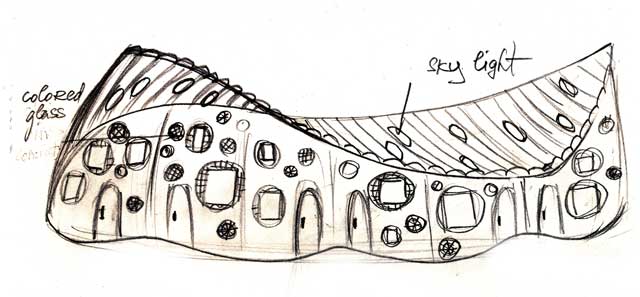
Initial Concept Drawing for the Cob Village

Initial Concept Drawings for the Cob Village
Initial Revit development of this village by Renata Maehara, Civil Engineering Student and Drafter

Initial Revit Designs

Initial Revit Designs
Here is a timelapse video of the lighting design work completed by Dean Scholz (Architectural Designer). This shows a progression of the many steps necessary to create the lighting in a real-to-life render like the ones above.
CONSULTANTS ON THE COB VILLAGE DESIGN
Dean Scholz: Architectural Designer
Diana Vieira: Architecture and Urban Planning Student
Douglas Simms Stenhouse: Architect and Water Color Artist
Flávia Galimberte Bozeda: Architecture and Interior Design Student
Guy Grossfeld: Graphic Designer
Jagannathan Shankar Mahadevan: Mechanical Engineer
Mayke Balbino: Architecture and Urban Design Student
Nelli Levental: MFA of Graphic Design and College Professor
Raquel de Oliveira Alves: Architecture and Urban Planning Student
Renata Maehara: Civil Engineering Student and Drafter
Sayonara Batista: 4th-year Architecture and Urban Planning Student
 One Community
One Community







